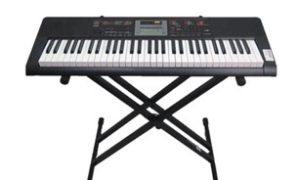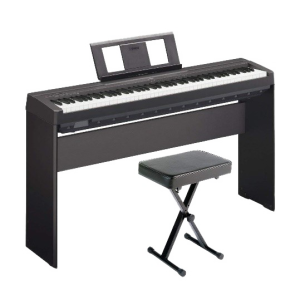Tips for Buying a Digital Piano
Considerations for Students
If possible, your piano should have:
- 88 fully-weighted keys with graded-hammer action
- USB port
- Dedicated piano bench (posture and height at the piano is very important)
- Furniture style stand (better than x-style)
- Sustain pedal
If possible, stick to the following brands:
- Roland
- Yamaha
- Kawai
- Korg
- Casio
If you buy something that looks like this…
This is a 61-key keyboard.

Pros: They are very affordable $149-300 (not including stand, bench, or pedal). They are portable and small.
Cons: Poorest sound quality of all choices. The keys do not feel the same as a real piano. Because they are unweighted, the student will be bothered by how heavy the keys of a real piano feel if they are used to the feel of a small keyboard. They will not develop the proper strength or musicianship over time. X-style stands can be awkward and unstable.
Why buy? If you are looking for an inexpensive keyboard to get your child started with, this will work. However, it is only a temporary purchase. You will need to upgrade after your child progresses to a more responsive instrument.
Popular brands: Yamaha, Casio
If you buy something that looks like this…
This is a basic digital piano.

Pros: You get closer to the sound and feel of a real piano at a good price. $500-700 (not including stand, bench, or pedal). Look for one with weighted keys and hammer action. You can control the volume, use headphones, and connect to a computer. Many come with the option of a furniture-style stand (pictured), which are more comfortable and stable than an x-style stand.
Cons: Even the best digital piano will not sound or feel exactly like an acoustic piano. They might break or malfunction after a few years (longevity varies with price). Sound quality and features differ widely with price. They usually sound best with headphones because speakers are usually small and limited due to size and portability.
Why buy? If your student is committed to piano, this is a great choice. It will meet all the needs of a piano student who is learning the basics of the instrument.
Popular brands: Roland, Yamaha, Kawai, Casio, Korg (most other brands not recommended)
If you buy something that looks like this…
This is a high-end digital piano.

Pros: You get closer to the sound and feel of a real piano at a good price. $500-700 (not including stand, bench, or pedal). Look for one with weighted keys and hammer action. You can control the volume, use headphones, and connect to a computer. Many come with the option of a furniture-style stand (pictured), which are more comfortable and stable than an x-style stand.
Pros: The best sound quality and key action in a digital instrument. Good digital pianos can last 10 – 20 years. High end digital pianos have expansive sound banks (they can sound like lots of other instruments), recording capabilities, and many interactive applications with computers. They are attractive additions to your home.
Cons: They are expensive. $1500 and up for digital pianos. They are heavy and not easily moved.
Why buy? If your student is serious about piano, or you want an instrument your whole family can enjoy for many years, this is a good investment. These instruments can handle the subtle nuances of touch to create a responsive, expressive sound. These are enjoyable to play and listen to, with or without headphones.
